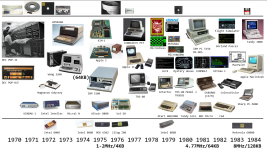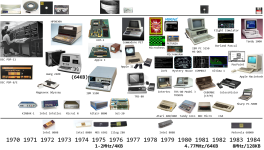voidstar78
Veteran Member
Chuck, those sounds like things Joe MacMillan would do (character from "Halt and Catch Fire"). Another story I recall - although not nearly as sinister -- but the "SX" CPUs in the 1990s? (I think that's how they were designated) Weren't those degraded or "rejected" DX versions of chips? Like 386DX vs 386SX. Something about the edges of the wafer as they were being produced, made them less capable processors and were sold at a discount (odd since if it was "edge defects", it would be less supply of those?).
Here's another updated V3 of this "mural", which I have a question below maybe ya'll can help:

- Added PC-5000 from Sharp. Not that this was the first "PC-typewriter" with a DOS in a ROM - but the PC-5000 was one of the early attempts, showing how quickly the industry ventured into "laptop computing" to use while on travel. But mainly the interesting thing to me about the PC-5000 was the attempt at using Bubble Memory - which I never quite understood much about (but apparently it wasn't faster or more reliable, nor cheaper). Anyhow, the transition from "luggables" to "laptops" is noteworthy. [ anyone know which laptop was first to have 2 hour battery, enough to last on a flight? the PC-5000 didn't yet have a battery ]
- Added COMMBAT :D Someday I'd like to see a WiModem used for some cross-platform vintage gaming. I understand why that wasn't viable in the early 1980s (even if the game existed, you didn't have anyone to connect to - or didn't have two phone lines - and developers didn't have the tools yet to easily make such software). But now with cc65 and modern development tools, we just need to get an API/SDK for the WiModem (maybe that will come about when the X16 rolls out).
What I need help with is, along the top... I added tape and disk. I know N-track tape (7-track, 9-track) was way earlier than 1970, my point is the DEC systems of 1970 still used those. Then there was the DC300 tape, which I'm not sure if it's accurate/fair to call that a reel-to-reel in miniature? (I only used a 9-track tape; did those have BOT/EOT marker holes?)
My question is, did the DEC paper tape come before 9-track? I think so, since in the PDP-1 manual I think it had an image of the paper-tape reader as a standard part of the system (as early as 1960). Did IBM do 9-track tape first, around 1965?
But then the 8" floppy and DC300 tape, those were around 1972, correct? The DC300 depends on a constantly spinning belt, which just seems very inefficient (will wear out and waste energy when not using it). But in those days, if you're bothering to power on the machine, you're probably heavily using it (and saving or loading something to/from the memory space), so maybe there wasn't that much idle time. Still, seems the IBM 5100 with the DC300 tape should have had an extra switch to power down the tape drive when not in heavy use. [ were the DEC's powered up for the day? for the week? or 24/7? or it just varied? ]
Was "rolled" paper-tape referred to anything differently, than the older "flat" paper-tape? Like if I needed to order some rolled paper-tape (instead of "flat" paper-tape), what would I go order from the store or catalog? I never had the honor of using punched tape :D
I'm not sure who first stored digital data on an audio tape. I recall reading about Chuck Peddle helping to perfect the timing on that when preparing the ROM for the PET. Obviously the concept came earlier, but who applied it to the standard audio media?
And I realize the 5.25" was closer to 1976. I still put it closer to 1980, as that's when they were more reliable and people could actually afford them (the Model 3's disk drive was around $850).
Here's another updated V3 of this "mural", which I have a question below maybe ya'll can help:

- Added PC-5000 from Sharp. Not that this was the first "PC-typewriter" with a DOS in a ROM - but the PC-5000 was one of the early attempts, showing how quickly the industry ventured into "laptop computing" to use while on travel. But mainly the interesting thing to me about the PC-5000 was the attempt at using Bubble Memory - which I never quite understood much about (but apparently it wasn't faster or more reliable, nor cheaper). Anyhow, the transition from "luggables" to "laptops" is noteworthy. [ anyone know which laptop was first to have 2 hour battery, enough to last on a flight? the PC-5000 didn't yet have a battery ]
- Added COMMBAT :D Someday I'd like to see a WiModem used for some cross-platform vintage gaming. I understand why that wasn't viable in the early 1980s (even if the game existed, you didn't have anyone to connect to - or didn't have two phone lines - and developers didn't have the tools yet to easily make such software). But now with cc65 and modern development tools, we just need to get an API/SDK for the WiModem (maybe that will come about when the X16 rolls out).
What I need help with is, along the top... I added tape and disk. I know N-track tape (7-track, 9-track) was way earlier than 1970, my point is the DEC systems of 1970 still used those. Then there was the DC300 tape, which I'm not sure if it's accurate/fair to call that a reel-to-reel in miniature? (I only used a 9-track tape; did those have BOT/EOT marker holes?)
My question is, did the DEC paper tape come before 9-track? I think so, since in the PDP-1 manual I think it had an image of the paper-tape reader as a standard part of the system (as early as 1960). Did IBM do 9-track tape first, around 1965?
But then the 8" floppy and DC300 tape, those were around 1972, correct? The DC300 depends on a constantly spinning belt, which just seems very inefficient (will wear out and waste energy when not using it). But in those days, if you're bothering to power on the machine, you're probably heavily using it (and saving or loading something to/from the memory space), so maybe there wasn't that much idle time. Still, seems the IBM 5100 with the DC300 tape should have had an extra switch to power down the tape drive when not in heavy use. [ were the DEC's powered up for the day? for the week? or 24/7? or it just varied? ]
Was "rolled" paper-tape referred to anything differently, than the older "flat" paper-tape? Like if I needed to order some rolled paper-tape (instead of "flat" paper-tape), what would I go order from the store or catalog? I never had the honor of using punched tape :D
I'm not sure who first stored digital data on an audio tape. I recall reading about Chuck Peddle helping to perfect the timing on that when preparing the ROM for the PET. Obviously the concept came earlier, but who applied it to the standard audio media?
And I realize the 5.25" was closer to 1976. I still put it closer to 1980, as that's when they were more reliable and people could actually afford them (the Model 3's disk drive was around $850).
Attachments
Last edited:



